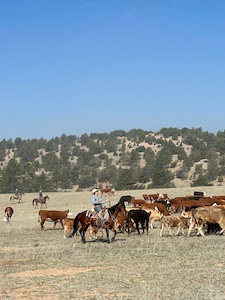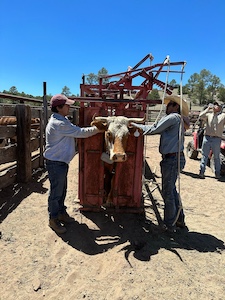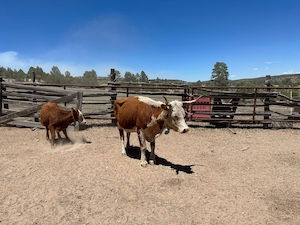 Photo courtesy of Kimberly Crumbley.Keeps cattle where they belong, tracks their movements, gives their location 24/7
Photo courtesy of Kimberly Crumbley.Keeps cattle where they belong, tracks their movements, gives their location 24/7
TRUTH OR CONSEQUENCES, NM, April 17, 2024 – Every once in a while, a new technology comes along that is a game changer for how things were done in the past. Like GIS and GPS changed mapping and wayfinding, and as the internet changed how we search for, share, and create information, so too has virtual fencing the potential to change the face of rangeland and livestock management. Vence® virtual fencing uses GPS-enabled collars mounted around the animals’ necks and a computer dashboard in combination with small, solar-powered communication stations to contain, track, and move animals across the landscape.
 Photo courtesy of Kimberly Crumbley.Back in 2022, during the Black Fire, New Mexico State University hosted a meeting in Winston, New Mexico to understand how they could help meet the needs of Gila National Forest grazing permittees, whose grazing allotments were burned over. Two permittees, on the Mineral Creek and Taylor Creek allotments, agreed to try virtual fencing as a way to manage their herds, given the damage sustained to their fence infrastructure. Last year, New Mexico State University announced it had been awarded more than $222,000 by the US Department of Agriculture’s National Institute of Food and Agriculture to support the project. The funds were a part of NIFA’s A1712 Rapid Response to Extreme Weather Events Across Food and Agricultural Systems.
Photo courtesy of Kimberly Crumbley.Back in 2022, during the Black Fire, New Mexico State University hosted a meeting in Winston, New Mexico to understand how they could help meet the needs of Gila National Forest grazing permittees, whose grazing allotments were burned over. Two permittees, on the Mineral Creek and Taylor Creek allotments, agreed to try virtual fencing as a way to manage their herds, given the damage sustained to their fence infrastructure. Last year, New Mexico State University announced it had been awarded more than $222,000 by the US Department of Agriculture’s National Institute of Food and Agriculture to support the project. The funds were a part of NIFA’s A1712 Rapid Response to Extreme Weather Events Across Food and Agricultural Systems.
 Photo courtesy of Kimberly Crumbley.“I think this project is exciting because it demonstrates how collaboration among ranchers, state agencies, federal agencies, and federal funding opportunities can be leveraged to address immediate needs in communities,” said Craig Gifford, Extension Beef Cattle Specialist at New Mexico State University. “The project has laid a foundation that can provide a template for future responses to wildfire, and also demonstrates the feasibility of virtual fence technology in the kind of rough-country pastures we have here in so much of New Mexico.”
Photo courtesy of Kimberly Crumbley.“I think this project is exciting because it demonstrates how collaboration among ranchers, state agencies, federal agencies, and federal funding opportunities can be leveraged to address immediate needs in communities,” said Craig Gifford, Extension Beef Cattle Specialist at New Mexico State University. “The project has laid a foundation that can provide a template for future responses to wildfire, and also demonstrates the feasibility of virtual fence technology in the kind of rough-country pastures we have here in so much of New Mexico.”
In May 2023, Fowler Cattle Company Ranch Manager Jack Crumbley oversaw the collaring of 100 head of Fowler cattle and began the journey of learning how to manage cattle differently. Through computer interface, he can view a topographic map of the Taylor Creek Allotment, the locations of virtual pastures he’s created, and the location of each of his cattle.
 Photo courtesy of Kimberly Crumbley.“This setup might save me hundreds of man-hours per month. Under the traditional method, if I let 100 cattle out into a pasture in rough country like this, I’m going to have to ride 10 hours a day over all that country for a month when it comes time to gather them up to move them. With the GPS collared cattle, I can check where they are on the computer, ride out to their location, and find them there. On occasion, if they’ve moved before I get to them, I can text my wife at home and she can send me an updated screenshot of where they are,” said Crumbley.
Photo courtesy of Kimberly Crumbley.“This setup might save me hundreds of man-hours per month. Under the traditional method, if I let 100 cattle out into a pasture in rough country like this, I’m going to have to ride 10 hours a day over all that country for a month when it comes time to gather them up to move them. With the GPS collared cattle, I can check where they are on the computer, ride out to their location, and find them there. On occasion, if they’ve moved before I get to them, I can text my wife at home and she can send me an updated screenshot of where they are,” said Crumbley.
Virtual fence lines are easily constructed by dropping pins on a digital map. Each pasture is laid out in polygons with up to 16-point locations so that water or other features can be included or dropped as needed.
“You have to kind of play with it to figure out what works best,” Crumbley said, adding, “you’re only limited by water and your imagination.”
Even more impressive, the Vence computer dashboard allows the user to visualize utilization of forage, due to the continual tracking of each animal’s movements, either individually or as a herd. The resulting map uses color-coding to show areas of heavier and lighter use by cattle. For those monitoring forage consumption, this makes it easier to monitor the right places, resulting in a more accurate picture of forage consumption across the allotment.
“By tracking where the cattle are spending their time, I can experiment with where I place salt or mineral blocks, and it’s amazing to see what a big difference it makes to put salt out on one ridge versus another 200 yards away, in terms of spreading the cattle out to different parts of the pasture,” said Crumbley.
Best of all, the program is helping the Forest Service meet its obligation to protect riparian grazing-exclusion zones from livestock entry. Virtually fenced shock zones now protect enticing riparian vegetation so successfully that physical fencing is not needed. Where flood-damaged water gaps previously allowed cattle to wander far outside of their allotment along the East Fork Gila River, no cattle were observed where they didn’t belong in 2023, for the first time in many years.
“The animal tracking component appears to potentially improve the efficiency of ranching operations in the region. With large corporations like Merck and Gallagher heavily invested in virtual fence systems, I expect research and development teams to greatly improve this technology in the coming years,” said Gifford. “Hopefully, the collars can eventually move to all-satellite communication, but the likely first steps will be for smaller collars, more refined virtual boundaries, longer-lasting batteries or solar power, and other immediate improvements.”
Virtual fencing is not a silver bullet – it can’t be expected to fully replace physical fencing in all places. In fact, in early 2024, the Gila National Forest partnered with Sierra Soil and Water Conservation and the National Forest Foundation to pack by mule and airlift by helicopter about 50 miles worth of fence materials to remote and difficult-to-access fence lines that were lost to the Black Fire.
With traditional barbed-wire fence construction costs of $30,000 per mile or more within the Black Fire depending on terrain, it makes sense to explore other options. The cow collars cost about $50 each per year, another $10,000 each for the communication stations, and the price of the computer program, the setup at Fowler Ranch cost somewhere in the neighborhood of $25,000, not including replacement batteries for the collars. And with the time and money savings from less fence maintenance and range riding to find hidden cattle, $25,000 never sounded so affordable.
Unfortunately, the pilot program with New Mexico State University will end in 2024, and a new pot of funds will need to be found to support continued application. The Forest Service is seeking partners who want to be a part of the solution to help fund Vence programs for these and other interested permittees.
You can learn more about the New Mexico State University’s virtual fencing grant at NMSU Extension team awarded NIFA grant for postfire response to establish virtual fencing. For more information contact Maribeth Pecotte at 575-388-8211 or Maribeth.Pecotte@usda.gov.


